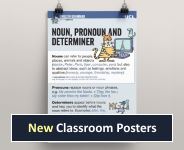Restrictive and non-restrictive relative clauses: Activity 1
In what situation would somebody use the clause the car which is yellow?
For example:
- The car which is yellow is mine, the car which is blue is yours, and the car which is red is John’s.
If I say the car which is yellow, am I giving you more information about a particular car we were already talking about by telling you its colour, or am I helping you to identify the car by telling you that it is the yellow one I want to discuss, rather than a red or blue one?
»
- Printer-friendly version
- Log in to view or leave comments


